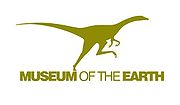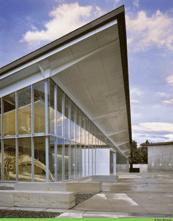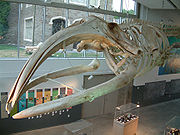
Museum of the Earth
Encyclopedia


Ithaca, New York
The city of Ithaca, is a city in upstate New York and the county seat of Tompkins County, as well as the largest community in the Ithaca-Tompkins County metropolitan area...
, on the campus of the PRI
Paleontological Research Institution
The Paleontological Research Institution, or PRI, is a natural history museum in Ithaca, New York with a mission including both research and education...
, its parent organization.
Paleontological Research Institution
PRIPaleontological Research Institution
The Paleontological Research Institution, or PRI, is a natural history museum in Ithaca, New York with a mission including both research and education...
was founded in 1932 by Gilbert Harris
Gilbert Harris
Gilbert Lloyd Harris is an American football running back who is currently a free agent. After going undrafted in the 2006 NFL Draft, Harris was out of football until he was signed by the Kansas City Chiefs in 2007. He played college football at Arizona.-External links:*...
, a professor of geology at Cornell University
Cornell University
Cornell University is an Ivy League university located in Ithaca, New York, United States. It is a private land-grant university, receiving annual funding from the State of New York for certain educational missions...
from 1894 to 1934. He founded PRI
Paleontological Research Institution
The Paleontological Research Institution, or PRI, is a natural history museum in Ithaca, New York with a mission including both research and education...
to house his collection of fossils and to publish research in paleontology
Paleontology
Paleontology "old, ancient", ὄν, ὀντ- "being, creature", and λόγος "speech, thought") is the study of prehistoric life. It includes the study of fossils to determine organisms' evolution and interactions with each other and their environments...
- the study of the history of life on Earth
Life on Earth
Life on Earth: A Natural History by David Attenborough is a television natural history series made by the BBC in association with Warner Bros. and Reiner Moritz Productions...
. PRI
Paleontological Research Institution
The Paleontological Research Institution, or PRI, is a natural history museum in Ithaca, New York with a mission including both research and education...
began as a small building behind Dr. Harris' home in Ithaca, New York
Ithaca, New York
The city of Ithaca, is a city in upstate New York and the county seat of Tompkins County, as well as the largest community in the Ithaca-Tompkins County metropolitan area...
. Through various additions over the next two decades, the original building grew into a 20-room complex that housed the Institution's collections, library, laboratories, and offices.
PRI
Paleontological Research Institution
The Paleontological Research Institution, or PRI, is a natural history museum in Ithaca, New York with a mission including both research and education...
has continued to grow through the years, requiring a move to larger quarters in 1968. The present facility on West Hill
West Hill
West Hill may refer to:in Canada* West Hill, Ontarioin the United Kingdom* West Hill, Brighton* West Hill, Wandsworth, London* West Hill School, Stalybridgein the United States...
, along Trumansburg Road (N.Y. Rte. 96), holds over 2 million fossils and shells, and a 50,000 volume research library. In 2003, PRI opened the 18000 square feet (1,672.3 m²) Museum of the Earth, a natural history museum that showcases PRI
Paleontological Research Institution
The Paleontological Research Institution, or PRI, is a natural history museum in Ithaca, New York with a mission including both research and education...
's specimens.
Exhibits
The Museum of the Earth showcases a wide selection of fossils from the collection of the Paleontological Research InstitutionPaleontological Research Institution
The Paleontological Research Institution, or PRI, is a natural history museum in Ithaca, New York with a mission including both research and education...
, which contains over 2 million specimens, from microfossils to large Ice Age
Ice age
An ice age or, more precisely, glacial age, is a generic geological period of long-term reduction in the temperature of the Earth's surface and atmosphere, resulting in the presence or expansion of continental ice sheets, polar ice sheets and alpine glaciers...
animals.
North Atlantic Right Whale #2030
In the spring of 2004 a permanent exhibit on North Atlantic Right Whale #2030 opened in the Museum lobby, funded by a grant from the Nelson B. Delavan Foundation. The exhibit includes a short film by David Brown featuring footage of the unsuccessful attempts to rescue #2030 from the fishing gear that ultimately ended her life. Visitors are told how PRIPaleontological Research Institution
The Paleontological Research Institution, or PRI, is a natural history museum in Ithaca, New York with a mission including both research and education...
and the Museum of the Earth aimed to create a memorial to the whale's life.
PRI
Paleontological Research Institution
The Paleontological Research Institution, or PRI, is a natural history museum in Ithaca, New York with a mission including both research and education...
’s North Atlantic Right Whale
North Atlantic Right Whale
The North Atlantic right whale which means "good, or true, whale of the ice") is a baleen whale, one of three right whale species belonging to the genus Eubalaena, formerly classified as a single species. With only 400 in existence, North Atlantic right whales are among the most endangered whales...
was mounted on a steel armature in a greenhouse on-site. The Museum building was left open on the northeast end so that the whale could be brought through for installation. In November 2002 a crane gently carried the pieces into the building and lifted them to the ceiling, where they were attached to a beam built into the roof specifically for the purpose of holding 8 tons of whale bones.


Rock of Ages Sands of Time
A 544-panel mural, each panel of which represents 1 million years, created by Ithaca artist Barbara Page. It seeks to give a new perspective on the emergence of life on earth. The panels represent an unbroken sequence of twelve geological periods that span an eon.A Journey Through Time
This exhibit leads visitors through the eons from the Big BangBig Bang
The Big Bang theory is the prevailing cosmological model that explains the early development of the Universe. According to the Big Bang theory, the Universe was once in an extremely hot and dense state which expanded rapidly. This rapid expansion caused the young Universe to cool and resulted in...
to the present day, aiming to challenge their perceptions about the present, future, and human effects and dependence on Earth
Earth
Earth is the third planet from the Sun, and the densest and fifth-largest of the eight planets in the Solar System. It is also the largest of the Solar System's four terrestrial planets...
.
- The CambrianCambrianThe Cambrian is the first geological period of the Paleozoic Era, lasting from Mya ; it is succeeded by the Ordovician. Its subdivisions, and indeed its base, are somewhat in flux. The period was established by Adam Sedgwick, who named it after Cambria, the Latin name for Wales, where Britain's...
, OrdovicianOrdovicianThe Ordovician is a geologic period and system, the second of six of the Paleozoic Era, and covers the time between 488.3±1.7 to 443.7±1.5 million years ago . It follows the Cambrian Period and is followed by the Silurian Period...
, and SilurianSilurianThe Silurian is a geologic period and system that extends from the end of the Ordovician Period, about 443.7 ± 1.5 Mya , to the beginning of the Devonian Period, about 416.0 ± 2.8 Mya . As with other geologic periods, the rock beds that define the period's start and end are well identified, but the...
Periods - visitors can watch the formation of the solar systemSolar SystemThe Solar System consists of the Sun and the astronomical objects gravitationally bound in orbit around it, all of which formed from the collapse of a giant molecular cloud approximately 4.6 billion years ago. The vast majority of the system's mass is in the Sun...
and planet EarthEarthEarth is the third planet from the Sun, and the densest and fifth-largest of the eight planets in the Solar System. It is also the largest of the Solar System's four terrestrial planets...
, and learn how the Cambrian ExplosionCambrian explosionThe Cambrian explosion or Cambrian radiation was the relatively rapid appearance, around , of most major phyla, as demonstrated in the fossil record, accompanied by major diversification of other organisms, including animals, phytoplankton, and calcimicrobes...
started life in the seas.
- Fossil Preparation Lab - visitors can interact with Museum staff as they prepare specimens for exhibition and research.
- Beneath an Ancient Sea - an exihibit about the warm, shallow seas which covered central New YorkNew YorkNew York is a state in the Northeastern region of the United States. It is the nation's third most populous state. New York is bordered by New Jersey and Pennsylvania to the south, and by Connecticut, Massachusetts and Vermont to the east...
380 million years ago. It includes a model of the 30 feet (9.1 m) carnivorous DunkleosteusDunkleosteusDunkleosteus is a genus of prehistoric fish, one of the largest arthrodire placoderms ever to have lived, existing during the Late Devonian period, about 380-360 million years ago.This hunter, measuring up to and weighing , was a hypercarnivorous apex predator...
from the DevonianDevonianThe Devonian is a geologic period and system of the Paleozoic Era spanning from the end of the Silurian Period, about 416.0 ± 2.8 Mya , to the beginning of the Carboniferous Period, about 359.2 ± 2.5 Mya...
period. Visitors can explore the process of plate tectonics that built the Appalachian MountainsAppalachian MountainsThe Appalachian Mountains #Whether the stressed vowel is or ,#Whether the "ch" is pronounced as a fricative or an affricate , and#Whether the final vowel is the monophthong or the diphthong .), often called the Appalachians, are a system of mountains in eastern North America. The Appalachians...
and the rapid biological evolution that was taking place at this time.
- CarboniferousCarboniferousThe Carboniferous is a geologic period and system that extends from the end of the Devonian Period, about 359.2 ± 2.5 Mya , to the beginning of the Permian Period, about 299.0 ± 0.8 Mya . The name is derived from the Latin word for coal, carbo. Carboniferous means "coal-bearing"...
, PermianPermianThe PermianThe term "Permian" was introduced into geology in 1841 by Sir Sir R. I. Murchison, president of the Geological Society of London, who identified typical strata in extensive Russian explorations undertaken with Edouard de Verneuil; Murchison asserted in 1841 that he named his "Permian...
, and TriassicTriassicThe Triassic is a geologic period and system that extends from about 250 to 200 Mya . As the first period of the Mesozoic Era, the Triassic follows the Permian and is followed by the Jurassic. Both the start and end of the Triassic are marked by major extinction events...
Periods
- Where Dinosaurs Walked - visitors can learn how ideas and depictions of dinosaurs changed with scientific discoveries, and how an animal adapts to its environment with games relating to and examples of natural selectionNatural selectionNatural selection is the nonrandom process by which biologic traits become either more or less common in a population as a function of differential reproduction of their bearers. It is a key mechanism of evolution....
.
- JurassicJurassicThe Jurassic is a geologic period and system that extends from about Mya to Mya, that is, from the end of the Triassic to the beginning of the Cretaceous. The Jurassic constitutes the middle period of the Mesozoic era, also known as the age of reptiles. The start of the period is marked by...
, CretaceousCretaceousThe Cretaceous , derived from the Latin "creta" , usually abbreviated K for its German translation Kreide , is a geologic period and system from circa to million years ago. In the geologic timescale, the Cretaceous follows the Jurassic period and is followed by the Paleogene period of the...
, and TertiaryTertiaryThe Tertiary is a deprecated term for a geologic period 65 million to 2.6 million years ago. The Tertiary covered the time span between the superseded Secondary period and the Quaternary...
Periods - visitors learn about the dominance and demise of dinosaurDinosaurDinosaurs are a diverse group of animals of the clade and superorder Dinosauria. They were the dominant terrestrial vertebrates for over 160 million years, from the late Triassic period until the end of the Cretaceous , when the Cretaceous–Paleogene extinction event led to the extinction of...
s through specimens, film, and images. The exhibit also teaches about the origin of birds and flowers and the mass extinction that killed the dinosaurs.
- A World Carved by Ice - visitors can explore how changes in climate affect life, and how glaciers formed the landscape of the Finger LakesFinger LakesThe Finger Lakes are a pattern of lakes in the west-central section of Upstate New York in the United States. They are a popular tourist destination. The lakes are long and thin , each oriented roughly on a north-south axis. The two longest, Cayuga Lake and Seneca Lake, are among the deepest in...
.
- Biodiversity and Extinction - this exhibits aims to make visitors reflect on how humans fit into the complex network of life on EarthEarthEarth is the third planet from the Sun, and the densest and fifth-largest of the eight planets in the Solar System. It is also the largest of the Solar System's four terrestrial planets...
and how the history of the EarthEarthEarth is the third planet from the Sun, and the densest and fifth-largest of the eight planets in the Solar System. It is also the largest of the Solar System's four terrestrial planets...
is an integral part of human life. Visitors are also shown the effects of both human and natural factors on extinct and endangered animals.
- The Gorge Garden - a garden that recreates the northeastern United StatesUnited StatesThe United States of America is a federal constitutional republic comprising fifty states and a federal district...
during the Ice AgeIce ageAn ice age or, more precisely, glacial age, is a generic geological period of long-term reduction in the temperature of the Earth's surface and atmosphere, resulting in the presence or expansion of continental ice sheets, polar ice sheets and alpine glaciers...
, with tundra vegetation, polished gravel, and large boulders (glacial erratics). This exhibit was funded by a grant from the Ithaca Garden Club.
Hyde Park Mastodon

University of Michigan
The University of Michigan is a public research university located in Ann Arbor, Michigan in the United States. It is the state's oldest university and the flagship campus of the University of Michigan...
. The bones were shipped in February 2003 to Prehistoric Animal Structures (PAST) of Calgary, Canada, where they built a non-invasive armature to mount the skeleton without damaging the bones. The armature and mastodon were then shipped to the Museum in summer 2003 for mounting.
Public Programs
Natural History at NoonOn two Saturdays of every month, the Museum invites noted speakers to give short talks about their areas of expertise. The topics are varied and include lectures ranging from the history of the universe to fossils found in the rocks of New York State, to the relationships between art and natural history. Talks are held in the Ray Van Houtte Museum classroom.
The James Potorti Interpretive Walk series, offered four Fridays in the Summer, explores the spectacular geology of the local New York State Park gorges.
Architecture
Based on the internationally known natural history collections of PRIPaleontological Research Institution
The Paleontological Research Institution, or PRI, is a natural history museum in Ithaca, New York with a mission including both research and education...
, the Museum of the Earth tells the story of the 4.6 billion year history of the Earth
Earth
Earth is the third planet from the Sun, and the densest and fifth-largest of the eight planets in the Solar System. It is also the largest of the Solar System's four terrestrial planets...
, focusing particularly on the Northeastern United States
Northeastern United States
The Northeastern United States is a region of the United States as defined by the United States Census Bureau.-Composition:The region comprises nine states: the New England states of Connecticut, Maine, Massachusetts, New Hampshire, Rhode Island and Vermont; and the Mid-Atlantic states of New...
.
The Museum occupies an 18000 square feet (1,672.3 m²) addition to the present PRI
Paleontological Research Institution
The Paleontological Research Institution, or PRI, is a natural history museum in Ithaca, New York with a mission including both research and education...
complex on Ithaca's West Hill. The new building was designed by the New York
New York
New York is a state in the Northeastern region of the United States. It is the nation's third most populous state. New York is bordered by New Jersey and Pennsylvania to the south, and by Connecticut, Massachusetts and Vermont to the east...
architectural firm of Weiss/Manfredi
Weiss/Manfredi
Weiss/Manfredi is an architectural firm headquartered in New York City, founded by Marion Weiss and Michael Manfredi. Weiss currently teaches at the University of Pennsylvania School of Design...
, recently best known for designing the award-winning women's war memorial at Arlington National Cemetery
Arlington National Cemetery
Arlington National Cemetery in Arlington County, Virginia, is a military cemetery in the United States of America, established during the American Civil War on the grounds of Arlington House, formerly the estate of the family of Confederate general Robert E. Lee's wife Mary Anna Lee, a great...
. The design for the Museum has attracted much critical notice.

